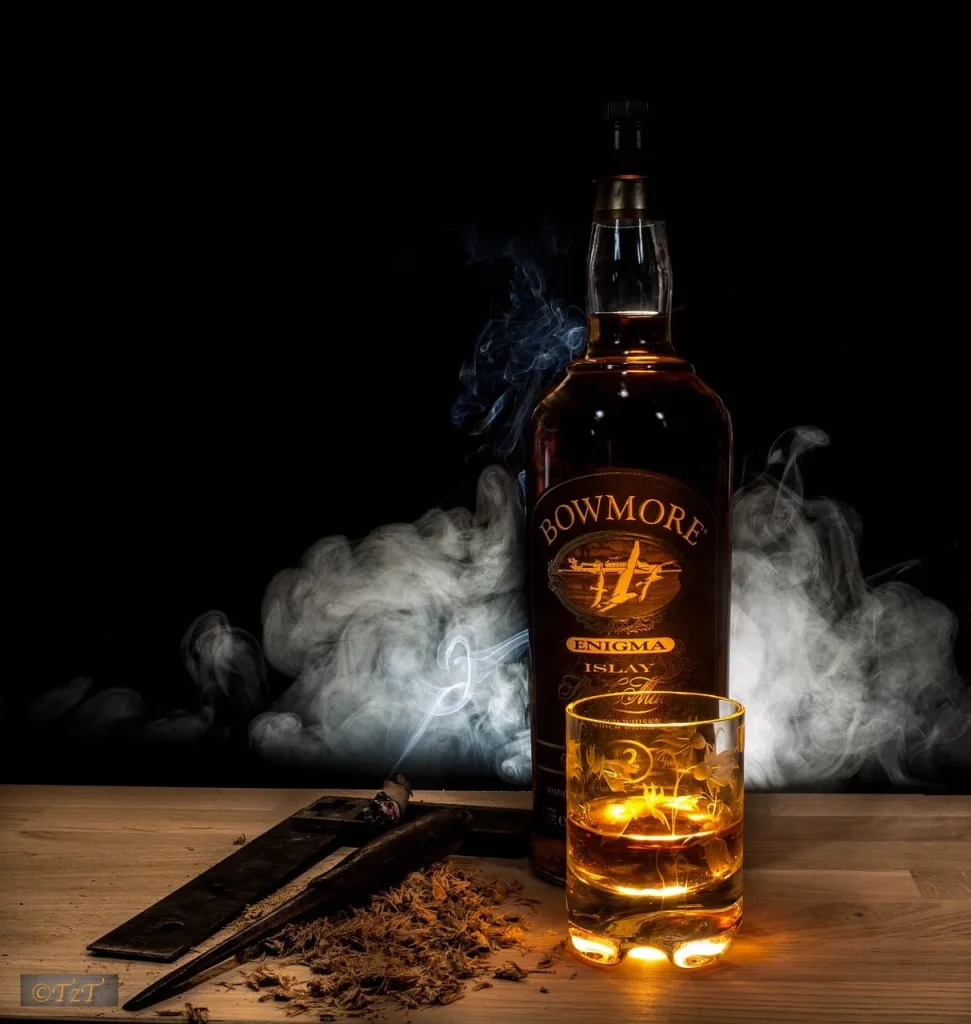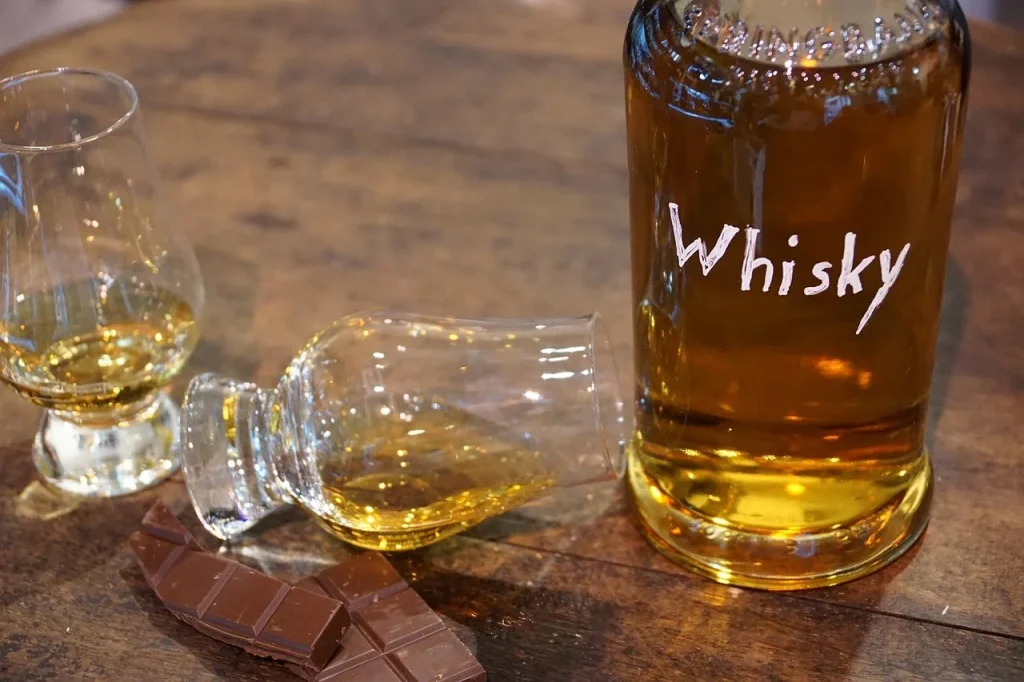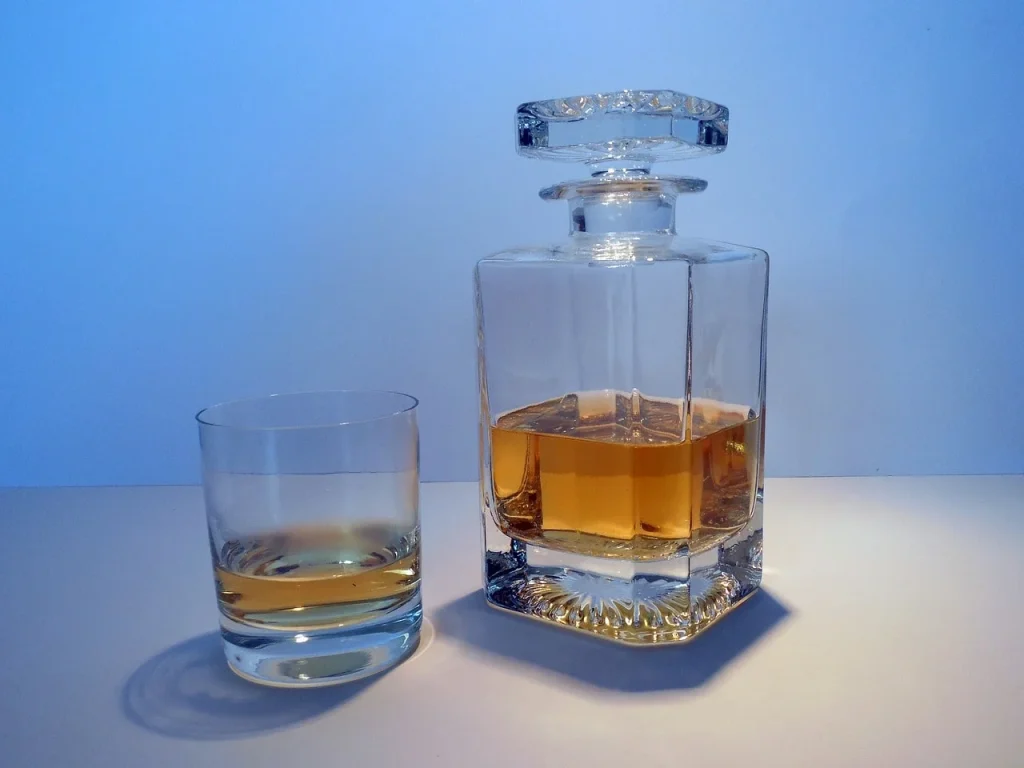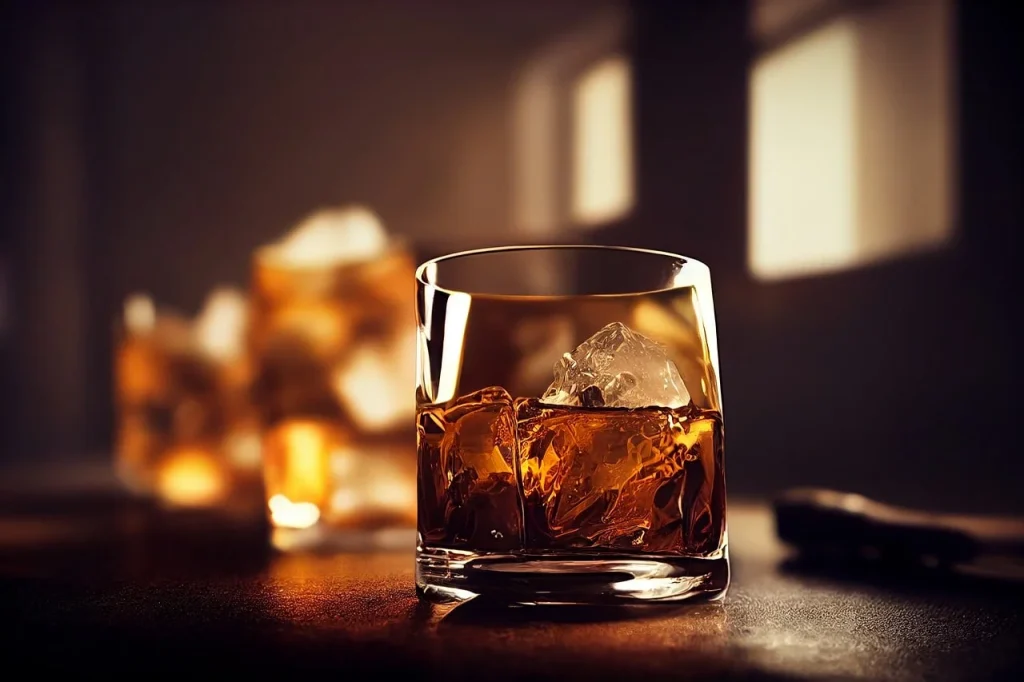Today, we’re rolling out the barrel on some fun facts about whiskey, your favorite amber elixir. This journey will take us from its smoky origins to the innovative distilling techniques of today.
Ever thought about why whiskey tastes better as it ages? It’s all in the barrels, which work their magic over the years to flavor up the spirit. But here’s a lighter take—whiskey lovers often argue whether it’s better neat or on the rocks, but really, isn’t any way that brings a smile to your face the right way?
As we explore deeper, think about what makes whiskey a staple of your celebrations. Ready to raise a glass to learning?
Too much of anything is bad, but too much good whiskey is barely enough.
Mark Twain
Whiskey Facts
Prepare to explore the realm of whiskey. Read each fact closely because, at the bottom of this article, a challenging quiz awaits those who claim to be experts. Are you ready?
- The Angel’s Share refers to the 4% evaporation loss from barrels each year, a charming term from distilling lore.
- Scotland has the highest number of distilleries in Europe, with more than 130 operational sites.
- A single malt comes from one distillery and must be aged in oak barrels for at least three years.
- The oldest known bottle dates back to 1843 and was distilled at the Glenavon Distillery in Scotland.
- During Prohibition, doctors could prescribe medicinal spirits, which were legally dispensed through pharmacies.
- Japan’s first distillery, Yamazaki, was established in 1923 and was greatly influenced by Scottish distilling techniques.
- The term “proof” dates back to the 18th century, when sailors would test liquor by igniting it to ensure it was strong enough.
- Master blenders can distinguish between thousands of flavors to ensure consistency and quality.
- The largest collection of unopened bottles is held in Scotland, featuring over 9,000 different examples.
- One of the most expensive bottles ever sold at auction fetched over $1.9 million and was a Macallan 1926.
- The Lincoln County Process, a unique filtering method through sugar maple charcoal, distinguishes Tennessee sour mash from other types.
- Whisky can be made from any grain, including corn, rye, wheat, and barley, each contributing to a unique flavor profile.
- The term “Scotch” exclusively refers to products distilled and matured in Scotland for a minimum of three years and one day.

- The duration of maturation greatly influences the flavor, as the spirit interacts with the wood.
- The color comes not from the distillation process but from the casks during maturation.
- India consumes more of this spirit than any other country, although much of it is locally produced and not traditional.
- Whisky stones are an alternative to ice that can cool the drink without diluting it.
- A “dram” is a common term for a glass of whisky in Scotland, a nod to traditional serving sizes.
- Surprisingly, collecting whiskies can yield higher returns than gold, according to investment analysts.
- Islay, a small island in Scotland, is renowned for its peaty and smoky whiskies, with nine distilleries packed into its 240 square miles.
- Some distilleries use a technique called “wood finishing,” where they transfer their products to second barrels previously used for other spirits for additional flavor complexity.
- The Whisky Belt is an informal term for a region stretching across Scotland’s Highlands to Speyside, famous for its concentration of distilleries.
- Peat used in production imparts a distinctive smoky flavor, depending on the peat’s origin and composition.
- Some collectors invest in casks rather than bottles, betting on the spirit’s value increasing over the years of maturation.
- The shape of the still affects the final spirit’s character, with taller stills producing a lighter and more delicate spirit.
- Blended whiskies comprise about 90% of the market, combining different grains and distillates for a consistent flavor.
- Some distilleries are turning to experimental cask types, like chestnut or mulberry, to push flavor boundaries.
- American and European oak are most commonly used for casks, each contributing different flavors such as vanilla or spice.

- Chill filtration is a process used to remove residue that could cloud the spirit when it is cold, though non-chill filtered versions are becoming more popular among enthusiasts.
- Subtle flavors in whisky, like almond, citrus, or caramel, come from specific interactions between the spirit and the wood’s chemicals.
- Some enthusiasts use a tasting wheel to help identify the complex array of possible flavors in each glass.
- The drink’s contact with air, called oxidation, can alter its taste after the bottle is opened.
- It’s a common misconception that older always means better; the balance and harmony of flavors are more critical indicators of quality.
- Cask strength refers to a spirit bottled from the cask without additional water, typically much stronger than standard.
- Innovative aging environments, such as underwater or in different climates, are being tested to explore new flavor developments.
- The world’s northernmost distillery is located in Norway and operates well within the Arctic Circle.
- A distillery’s location, especially its water source, can significantly influence the spirit’s final taste.
- Silent distilleries, those no longer in operation, often have bottles that become highly sought after due to their rarity.

- Barley malting stages can include smoking over peat, which imparts additional flavors to the final spirit.
- The closure of a bottle, whether cork or screw cap, can influence oxidation rates and flavor changes over time.
- Legally, Irish and American versions must spell it as “whiskey,” while Scotland, Canada, and Japan use “whisky.”
- A “vertical tasting” involves sampling from one distillery but from multiple years to understand how different conditions affected the products.
- Ex-bourbon casks are commonly used for aging, giving sweet and vanilla notes to the spirit.
- Some rare editions are known for their collectors’ value rather than consumption, with certain unopened bottles being museum pieces.
- Intricate crystal decanters are sometimes used to enhance the aesthetic appeal and perceived value of premium bottles.
- Micro-distilleries have surged in popularity, contributing to the craft movement with small-batch and artisanal products.
- Awards and ratings by experts can significantly influence a brand’s market perception and demand.
- Whisky tourism is a significant industry, with enthusiasts traveling globally to visit famous distilleries and regions.
- Creative marketing, like storytelling and heritage, plays a crucial role in branding and customer loyalty.
- Blind tasting challenges even the most seasoned tasters to identify products without the influence of brand and presentation.
Whiskey Myths

Now that we’ve covered the facts, it’s time to tackle the myths. Join me as we separate fact from fiction in the world of whiskey.
- Whiskey Should Always Be Sipped Neat
It is often believed that it should be enjoyed neatly to appreciate its full flavor. However, a splash of water can be added, as it is said to open up more flavors in the whiskey by reducing the strength of the alcohol, which can overpower the palate. - Older Whiskeys Are Always Better
While a longer aging process can enhance its complexity, it is not always preferable. The balance and appeal of whiskey are subjective and can be perceived as being optimal at various ages. - Whiskey Must Be Made in Scotland to Be Authentic
It is a common misconception that only Scottish whiskey is genuine. In truth, whiskey is produced worldwide, and many regions, including the U.S., Ireland, and Japan, are known for distinctive and highly regarded whiskeys. - Single Malt Whiskey is Superior to Blended Whiskey
Single malt whiskeys are often highlighted as premium. However, blended whiskeys can also offer high quality and complexity. It is recognized that the skillful blending of various whiskeys brings out a range of flavors that are much appreciated. - Whiskey is a Man’s Drink
The stereotype that it is primarily for men is outdated. It is enjoyed by people of all genders, and it has been found that women are just as likely to appreciate the rich tapestry of flavors that it offers.
No products found.
Whiskey Quotes

Prepare to raise a glass as we get into the world of whiskey through the words of those who have been captivated by its warmth, complexity, and rich history.
Whiskey is liquid sunshine.
George Bernard Shaw
George Bernard Shaw, the Irish playwright and critic known for his sharp wit, referred to whiskey with this metaphor, highlighting its warmth and enjoyable essence as if it were sunshine in liquid form.
I’m on a whisky diet. I’ve lost three days already.
Tommy Cooper
Tommy Cooper, a British magician and comedian known for his slapstick humor and one-liners, joked about the effects of drinking whiskey in this quip, playfully suggesting its ability to obliterate one’s sense of time.
Always carry a flagon of whiskey in case of snakebite and furthermore always carry a small snake.
W.C. Fields
W.C. Fields, an American comedian and actor, was famous for his comedic advice and dry wit. This quote displays his humorous approach to justifying drinking whiskey under the guise of emergency preparedness.
There is no bad whiskey. There are only some whiskeys that aren’t as good as others.
Raymond Chandler
Raymond Chandler, an American-British novelist and screenwriter, often infused his works with his fondness for whiskey. This quote reflects his nuanced view of whiskey, suggesting a universal appreciation regardless of quality.
Happiness is having a rare steak, a bottle of whisky, and a dog to eat the rare steak.
Johnny Carson
Johnny Carson, the legendary American television host, humorously described his simple formula for happiness in this quote, placing whiskey at the center of his ideal scenario alongside good food and a touch of humor involving his dog.
Whiskey FAQ

We approach the final section before our quiz. Read these FAQs carefully to get a better score on the upcoming trivia.
- Can whiskey freeze?
Indeed, it can freeze, but it requires much colder temperatures than your average household freezer, which typically goes down to 0°F (-18°C). Whiskey, with its high alcohol content, freezes closer to -17°F (-27°C). - Will whiskey help a toothache?
It has been used as a traditional remedy for easing toothache pain, primarily because the alcohol it contains can act as an antiseptic and numbing agent. However, it’s not a cure for underlying issues, so consider it more of a temporary relief, and don’t forget to see a dentist for proper treatment. - Can whiskey go bad?
It doesn’t spoil like food, but it can deteriorate in quality over a long time, especially if it’s not stored properly. Exposure to light, extreme temperatures, or air can alter its flavor. But generally, if you keep it sealed and store it in a cool, dark place, it can maintain its taste for years. - What whiskey is gluten-free?
It is typically gluten-free. Even though it’s made from grains that contain gluten, the distillation process should remove most, if not all, of the gluten proteins. However, if you’re highly sensitive or have celiac disease, you might want to stick with whiskeys that are certified gluten-free or opt for brands that don’t use any gluten grains at all. - Are whiskey and bourbon the same?
Not quite. While all bourbon is whiskey, not all whiskey is bourbon. Bourbon is a type of American whiskey with specific rules: it must be made in the U.S., contain at least 51% corn, and be aged in new charred oak barrels, among other regulations. Whiskey, on the other hand, is a broader category that includes various types based on their ingredients, distillation processes, and geographic origins.
No products found.
Whiskey Trivia

Think you know your whiskey? Let’s put your spirits to the test! Fail to answer correctly, and it’s a year of only wine coolers for you!
Conclusion
Our journey through the diverse landscape of whiskey ends here, but your adventure is just beginning. With every pour, you encounter a new aspect of its rich character.
Whether it’s the fiery spice of a rye or the mellow sweetness of an aged Scotch, whiskey always has more to unveil. So, keep exploring, tasting, and enjoying—there’s a whole world in each bottle, waiting to be discovered. Cheers.


